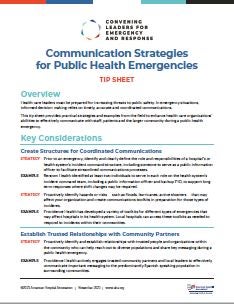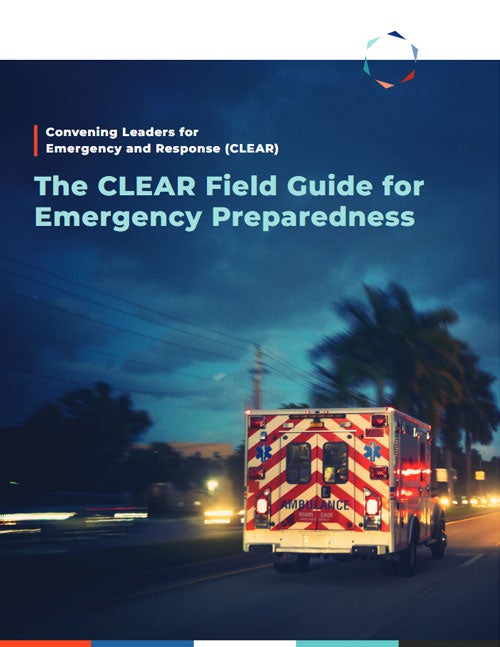Tip Sheet Overview
Health care leaders must be prepared for increasing threats to public safety. In emergency situations, informed decision-making relies on timely, accurate and coordinated communications.
This tip sheet provides practical strategies and examples from the field to enhance health care organizations’ abilities to effectively communicate with staff, patients and the larger community during a public health emergency.
Key Considerations
Establish Trusted Relationships with Community Partners
Strategy: Proactively identify and establish relationships with trusted people and organizations within the community who can help reach out to diverse populations and share key messaging during a public health emergency.
Example: Providence actively engages trusted community partners and local leaders to effectively communicate important messaging to the predominantly Spanish-speaking population in surrounding communities.
Communicate with Transparency and Openness
Strategy: Be transparent in communications with patients, staff and the public. For example, acknowledge the unknowns and when guidance is evolving, as the situation may change over time as more information is gathered.
Example: Renown Health uses an SMS secured messaging system to provide timely updates and guidance to staff during emergencies, ensuring that individuals feel well informed and are kept “in the loop,” especially during evolving situations.
Leverage Social Media Channels
Strategy: Leverage communications channels that are within your organization’s control — such as social media accounts, websites and podcasts — to proactively communicate guidance and situational updates to the community.
Example: During the COVID-19 pandemic, Providence used Facebook Live events as a way to consistently reach and engage with its various communities, providing evolving and timely guidance about prevention and treatment of COVID-19.
Harness Lessons Learned to Drive Improvement and Growth
Strategy: Use each crisis or emergency as an opportunity for learning and growth. Conduct a “hotwash” or after-action review to identify strengths, areas for improvement and tangible action steps to take, addressing known gaps in emergency plans and protocols.
Example: Early in the COVID-19 pandemic, Renown Health identified a lack of patient engagement via the MyChart health information app. To increase use by patients, the health system intentionally made vaccine appointments available solely through the MyChart app, thus requiring more people to use the app to schedule and get vaccinations.
Create Structures for Coordinated Communications
Strategy: Prior to an emergency, identify and clearly define the role and responsibilities of a hospital’s or health system’s incident command structure, including someone to serve as a public information officer to facilitate streamlined communications processes.
Example: Renown Health identified at least two individuals to serve in each role on the health system’s incident command team, including a public information officer and backup PIO, to support longterm responses where shift changes may be required.
Strategy: Proactively identify hazards or risks — such as floods, hurricanes, active shooters — that may affect your organization and create communications toolkits in preparation for those types of incidents.
Example: Providence has developed a variety of toolkits for different types of emergencies that may affect hospitals in its health system. Local hospitals can access these toolkits as needed to respond to incidents within their communities.
Reflection Questions
- Do your organization’s current emergency plans consider how to reach internal and external audiences, including diverse populations in your community?
- Is your organization using social media platforms available across your community to create easily accessible and trusted messaging channels?
- Have you identified community partners and established trusted relationships with them to aid in dispersing guidance and key messaging during a public health emergency?
- Do you have a process in place to debrief and gather feedback following an emergency, driving improvement in emergency plans and protocols?
Presented as part of Cooperative Agreement 5 HITEP210047-02-00, funded by the Department of Health and Human Services’ Administration for Strategic Preparedness and Response (ASPR). The Health Research & Educational Trust, an American Hospital Association 501(c)(3) nonprofit subsidiary, is a proud partner of this Cooperative Agreement. This publication is solely the responsibility of the Health Research & Educational Trust and its partners and does not necessarily represent the official policies or views of the Department of Health and Human Services or of the Administration for Strategic Preparedness and Response. Further, any mention of trade names, commercial practices, or organizations does not imply endorsement by the U.S. Government.



